Refractive Index Measurement of Glass with Arbitrary Shape Based on Brewster’s Law and a Focusing Probe Beam
Abstract
1. Introduction
2. Measurement Principle
2.1. System Structure
2.2. Measurement of the Brewster Angle
2.3. Symmetric Measurement Scheme
3. Experiments and Results
3.1. Experiemental Setup
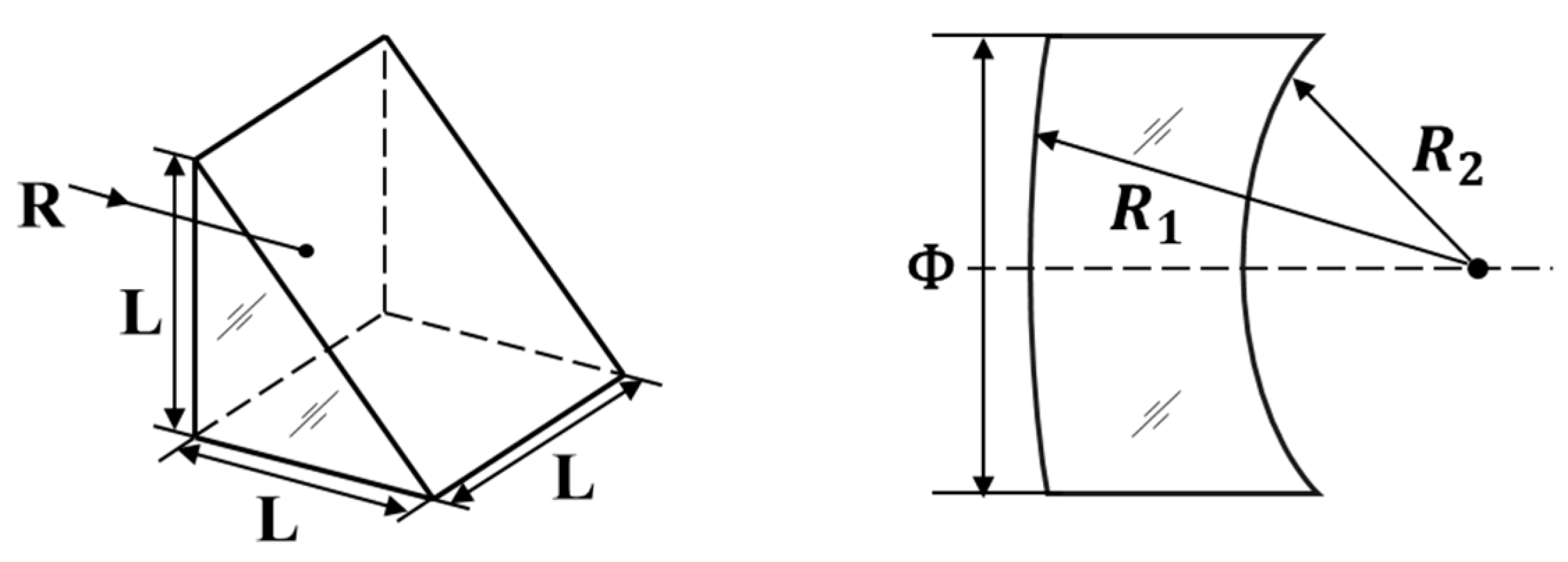
| Serial Number | Shape | Material | Refractive Index (632.8 nm) | Diameter or Size Φ or L/mm | ROC | ROC |
|---|---|---|---|---|---|---|
| 1 | Prism | H-K9L | 1.5151 | 25.4 | ∞ | -- |
| 2 | Lens | N-BK7 | 1.5151 | 25.4 | 1029.8 | −1029.8 |
| 3 | Lens | N-BK7 | 1.5151 | 25.4 | 515.1 | ∞ |
| 4 | Lens | N-BK7 | 1.5151 | 25.4 | 386.3 | ∞ |
| 5 | Lens | ZF7 | 1.7999 | 50.8 | 1074.58 | 41.54 |
3.2. Refractive Index Measurement of the Samples
3.2.1. Measurement of the Samples with Different Shapes
| Sequence | Sample No. 1 | Sample No. 2 | Sample No. 3 | Sample No. 4 | ||||||||
|---|---|---|---|---|---|---|---|---|---|---|---|---|
| RIC | RIAC | RIA | RIC | RIAC | RIA | RIC | RIAC | RIA | RIC | RIAC | RIA | |
| 1 | 1.5188 | 1.5105 | 1.5146 | 1.5186 | 1.5103 | 1.5145 | 1.5187 | 1.5104 | 1.5145 | 1.5187 | 1.5105 | 1.5146 |
| 2 | 1.5188 | 1.5104 | 1.5146 | 1.5188 | 1.5104 | 1.5145 | 1.5186 | 1.5107 | 1.5146 | 1.5185 | 1.5106 | 1.5145 |
| 3 | 1.5188 | 1.5104 | 1.5146 | 1.5188 | 1.5103 | 1.5145 | 1.5186 | 1.5104 | 1.5145 | 1.5188 | 1.5104 | 1.5146 |
| 4 | 1.5187 | 1.5105 | 1.5146 | 1.5189 | 1.5104 | 1.5146 | 1.5186 | 1.5103 | 1.5144 | 1.5184 | 1.5103 | 1.5144 |
| 5 | 1.5185 | 1.5104 | 1.5146 | 1.5188 | 1.5105 | 1.5147 | 1.5188 | 1.5104 | 1.5145 | 1.5188 | 1.5103 | 1.5145 |
| 6 | 1.5187 | 1.5104 | 1.5145 | 1.5188 | 1.5104 | 1.5146 | 1.5187 | 1.5105 | 1.5146 | 1.5186 | 1.5107 | 1.5147 |
| 7 | 1.5188 | 1.5104 | 1.5146 | 1.5187 | 1.5104 | 1.5146 | 1.5187 | 1.5106 | 1.5146 | 1.5185 | 1.5106 | 1.5146 |
| 8 | 1.5186 | 1.5103 | 1.5145 | 1.5187 | 1.5106 | 1.5147 | 1.5188 | 1.5104 | 1.5145 | 1.5186 | 1.5106 | 1.5146 |
| 9 | 1.5187 | 1.5104 | 1.5145 | 1.5188 | 1.5106 | 1.5147 | 1.5186 | 1.5105 | 1.5145 | 1.5188 | 1.5105 | 1.5146 |
| 10 | 1.5187 | 1.5104 | 1.5146 | 1.5188 | 1.5107 | 1.5147 | 1.5186 | 1.5106 | 1.5146 | 1.5188 | 1.5105 | 1.5146 |
| Average | 1.5187 | 1.5104 | 1.5146 | 1.5188 | 1.5105 | 1.5146 | 1.5187 | 1.5105 | 1.5145 | 1.5187 | 1.5105 | 1.5146 |
| standard deviation (×10−5) | 9.0 | 5.1 | 4.6 | 7.8 | 12.8 | 7.5 | 7.8 | 11.7 | 6.4 | 14.3 | 12.6 | 7.8 |
3.2.2. Measurement of the Samples with Different Refractive Indices
4. Error Analyses
4.1. Error Analyses of the System
4.1.1. Refractive Index Measurement Error of Air
4.1.2. Angular Measurement Error
4.1.3. Angular Measurement Error
4.1.4. Synthesis Error
4.2. Error Analyses of the Symmetric Measurement Scheme
4.3. Error Budget of the Results
5. Conclusions
- Compared with the liquid immersion method, the refractive index can be tested directly in the air.
- Compared with the current non-immersion method, the proposed method does not require the structural parameters of the tested samples. Thus, the method can be used regardless of the shape of the sample, and the measurement process is clear and simple.
- The refractive index is tested by noninterference measurement, given that the method is robust to noise and environmental vibrations.
Author Contributions
Funding
Institutional Review Board Statement
Informed Consent Statement
Data Availability Statement
Conflicts of Interest
References
- Singh, S. Refractive index measurement and its applications. Phys. Scr. 2002, 65, 167–180. [Google Scholar] [CrossRef]
- Cardin, J.; Leduc, D. Determination of refractive index, thickness, and the optical losses of thin films from prism-film coupling measurements. Appl. Opt. 2008, 47, 894–900. [Google Scholar] [CrossRef] [PubMed]
- Talim, S.P. Measurement of the Refractive Index of a Prism by a Critical Angle Method. Opt. Acta 1978, 25, 157–165. [Google Scholar] [CrossRef]
- Choi, H.J.; Lim, H.H.; Moon, H.S.; Eom, T.B.; Ju, J.J.; Cha, M. Measurement of refractive index and thickness of transparent plate by dual-wavelength interference. Opt. Express 2010, 18, 9429–9434. [Google Scholar] [CrossRef] [PubMed]
- Alvin, M.G. Optical interference method for the approximate determination of refractive index and thickness of a transparent layer. Appl. Opt. 1978, 17, 2779–2787. [Google Scholar]
- Pedinoff, M.E.; Braunstein, M.; Stafsudd, O.M. Refractive indices of ir materials: 10.6-μm ellipsometer measurements. Appl. Opt. 1977, 16, 2849–2856. [Google Scholar] [CrossRef] [PubMed]
- Joo, K.N.; Kim, S.W. Refractive index measurement by spectrally resolved interferometry using a femtosecond pulse laser. Opt. Lett. 2007, 32, 647–649. [Google Scholar] [CrossRef]
- Maeng, S.; Park J, O.B.; Jin, J. Uncertainty improvement of geometrical thickness and refractive index measurement of a silicon wafer using a femtosecond pulse laser. Opt. Express 2012, 20, 12184–12190. [Google Scholar] [CrossRef]
- Park, J.; Bae, J.; Jin, J.; Kim, J.A.; Kim, J.W. Vibration-insensitive measurements of the thickness profile of large glass panels. Opt. Express 2015, 23, 32941–32949. [Google Scholar] [CrossRef]
- Park, J.; Bae, J.; Jang, Y.S.; Jin, J.V. A novel method for simultaneous measurement of thickness, refractive index, bow, and warp of a large silicon wafer using a spectral-domain interferometer. Metrologia 2020, 57. [Google Scholar] [CrossRef]
- Su, L.J.; Chen, Y.; Yi, A.Y.; Klocke, F.; Pongs, G. Refractive index variation in compression molding of precision glass optical components. Appl. Opt. 2008, 47, 1662–1667. [Google Scholar] [CrossRef] [PubMed]
- Zhao, W.; Chen, Y.; Shen, L.G.; Yi, A.Y. Refractive index and dispersion variation in precision optical glass molding by computed tomography. Appl. Opt. 2009, 48, 3588–3595. [Google Scholar] [CrossRef] [PubMed]
- Smith, G. Liquid immersion method for the measurement of the refractive index of a simple lens. Appl. Opt. 1982, 21, 755–757. [Google Scholar] [CrossRef]
- Kasana, R.S.; Rosenbruch, K.J. Determination of the refractive index of a lens using the Murty shearing interferometer. Appl. Opt. 1983, 22, 3526–3531. [Google Scholar] [CrossRef] [PubMed]
- Hiroyuki, S. Interferometric measurement of the refractive-index distribution in plastic lenses by use of computed tomography. Appl. Opt. 2002, 41, 5317–5325. [Google Scholar]
- Kasana, R.S.; Goswami, A.; Soni, K. R Non-destructive multiple beam interferometric technique for measuring the refractive indices of lenses. Opt. Commun. 2004, 236, 289–294. [Google Scholar] [CrossRef]
- Kasana, R.S.; Boseck, S.; Rosenbruch, K.-J. Use of a grating in a coherent optical-processing configuration for evaluating the refractive index of a lens. Appl. Opt. 1984, 23, 757–761. [Google Scholar] [CrossRef]
- Soni, K.; Kasana, R.S. The role of an acousto-optic grating in determining the refractive index of a lens. Meas. Sci. Technol. 2007, 18, 1667–1671. [Google Scholar] [CrossRef]
- Soni, K.; Kasana, R.S. The use of defocused position of a Ronchi grating for evaluating the refractive index of lens. Opt. Laser Technol. 2007, 65, 1334–1338. [Google Scholar] [CrossRef]
- Chen, C.-H.; Tsao, T.-C.; Tang, J.-L.; Wu, W.-T. A Multi-D-Shaped Optical Fiber for Refractive Index Sensing. Sensors 2010, 10, 4794–4804. [Google Scholar] [CrossRef] [PubMed]
- Meng, Z.; Zhai, X.; Wei, J.; Wang, Z.; Wu, H. Absolute Measurement of the Refractive Index of Water by a Mode-Locked Laser at 518 nm. Sensors 2018, 18, 1143. [Google Scholar] [CrossRef] [PubMed]
- Chhaniwal, V.K.; Anand, A.; Narayanamurthy, C.S. Determination of refractive indices of biconvex lenses by use of a Michelson interferometer. Appl. Opt. 2006, 65, 3985–3990. [Google Scholar] [CrossRef]
- Chhaniwal, V.K.; Kihiko, J.M.; Dubey, S.; Shearon, G.; Javidi, B.; Anand, A. Digital holographic testing of biconvex lenses. Appl. Opt. 2013, 52, 8714–8722. [Google Scholar] [CrossRef]
- Chen, L.F.; Guo, X.F.; Hao, J.J. Lens refractive index measurement based on fiber point-diffraction longitudinal interferometry. Opt. Express 2013, 21, 22389–22399. [Google Scholar] [CrossRef] [PubMed]
- Zhao, W.Q.; Qiu, L.R.; Xiao, Y.; Yang, J.M. Laser differential confocal interference multi parameter comprehensive measurement method and its system for spherical lens. Opt. Express 2016, 24, 22813–22829. [Google Scholar] [CrossRef]
- Ouseph, P.J.; Driver, K.; Conklin, J. Polarization of light by reflection and the Brewster angle. Am. J. Phys. 2001, 69, 1166–1168. [Google Scholar] [CrossRef]
- Bahrim, C.; Hsu, W.T. Precise measurements of the refractive indices for dielectrics using an improved Brewster angle method. Am. J. Phys. 2009, 77, 337–343. [Google Scholar] [CrossRef]
- Sumer, C.; Kustepeli, A.; Dinleyici, M.S. Investigating the experimental limits of the Brewster’s angle method. Turk. J. Electr. Eng. Co. 2018, 26, 1202–1213. [Google Scholar]
- Paolino, P.; Bellon, L. Single beam interferometric angle measurement. Opt. Commun. 2007, 280, 1–9. [Google Scholar] [CrossRef][Green Version]
- Matsukuma, H.; Madokoro, S.; Astuti, W.D.; Shimizu, Y.; Wei, G. A New Optical Angle Measurement Method Based on Second Harmonic Generation with a Mode-Locked Femtosecond Laser. Nanomanuf. Metrol. 2019, 2, 187–198. [Google Scholar] [CrossRef]
- Edlén, B. The Refractive Index of Air. Metrologia 1966, 2, 71–80. [Google Scholar] [CrossRef]
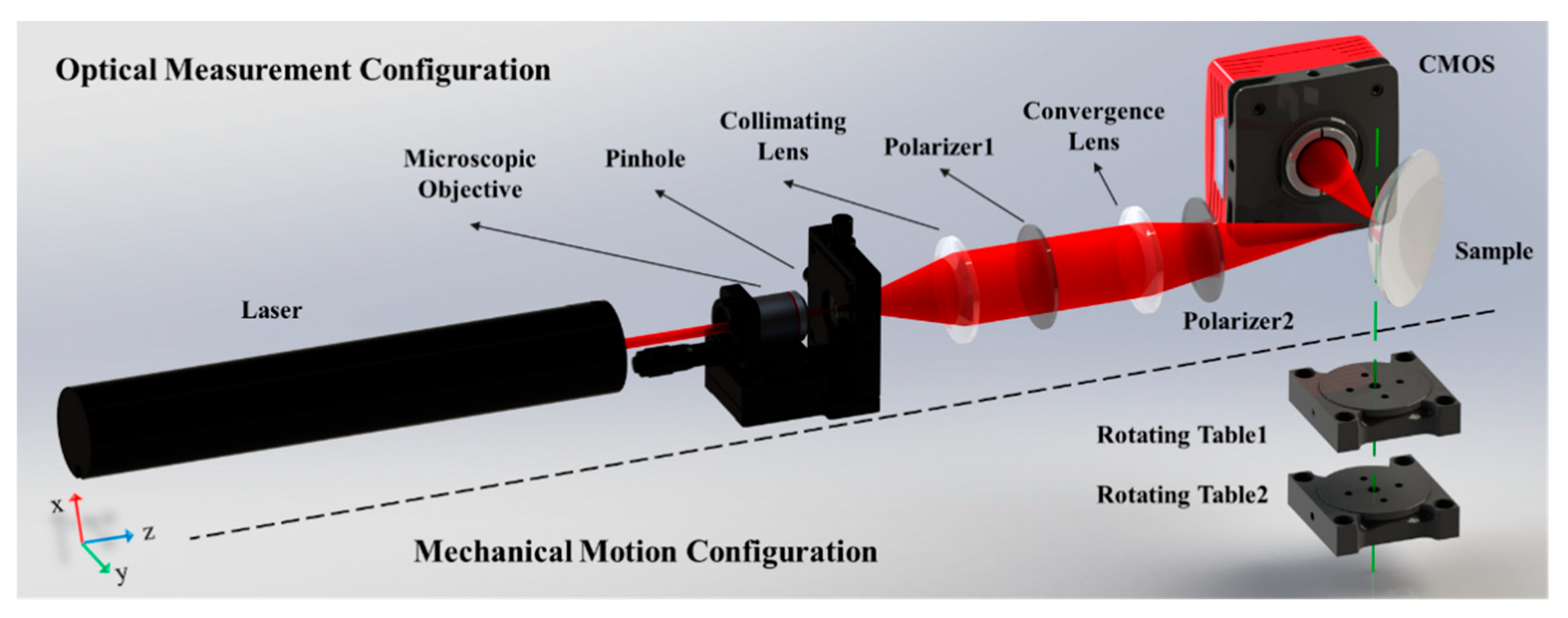
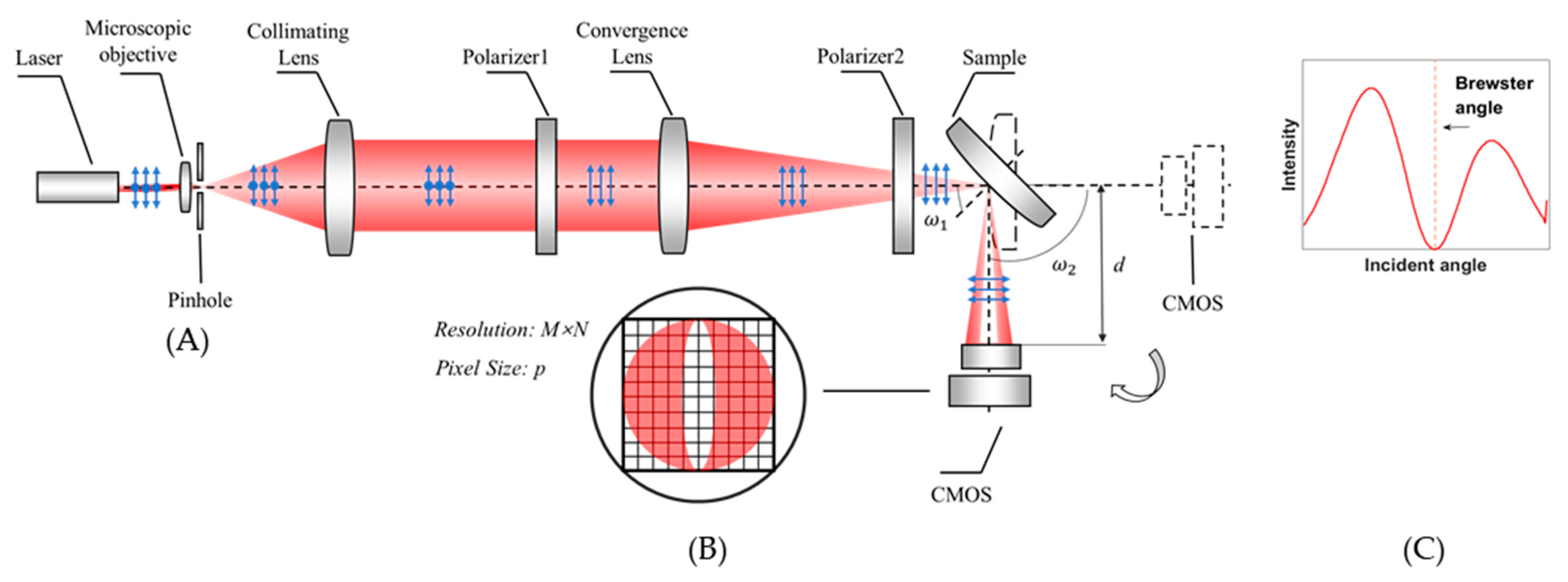


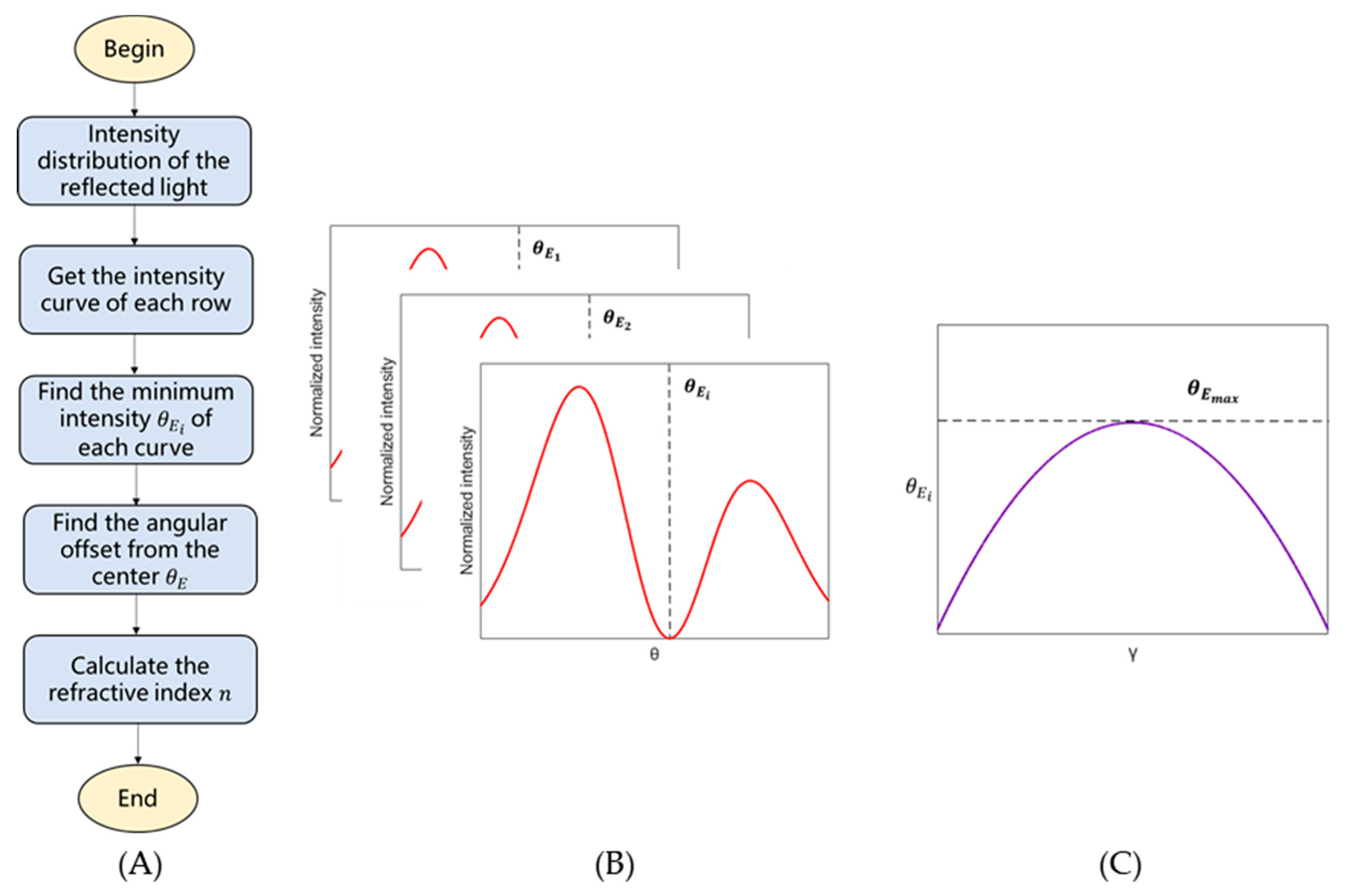



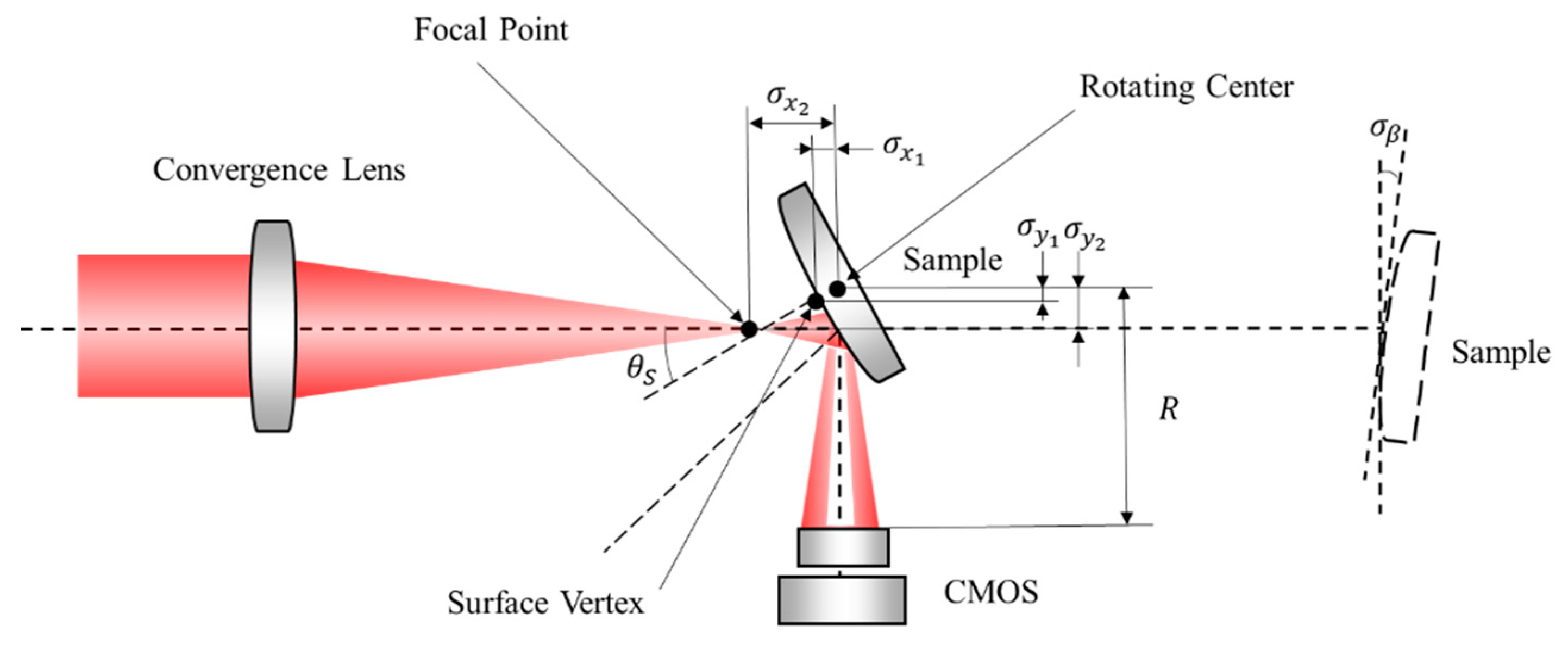
| Sequence | RIC | RIAC | RIA |
|---|---|---|---|
| 1 | 1.8053 | 1.7953 | 1.8003 |
| 2 | 1.8054 | 1.7952 | 1.8003 |
| 3 | 1.8054 | 1.7953 | 1.8003 |
| 4 | 1.8055 | 1.7953 | 1.8004 |
| 5 | 1.8055 | 1.7952 | 1.8004 |
| 6 | 1.8055 | 1.7953 | 1.8004 |
| 7 | 1.8055 | 1.7953 | 1.8004 |
| 8 | 1.8057 | 1.7953 | 1.8005 |
| 9 | 1.8054 | 1.7954 | 1.8004 |
| 10 | 1.8055 | 1.7953 | 1.8004 |
| Average | 1.8055 | 1.7953 | 1.8004 |
| Standard deviation | 1.0 × 10−4 | 5.1 × 10−5 | 7.1 × 10−5 |
| Error Sources | |||
|---|---|---|---|
| −1 | 1 | 0 | |
| 0 |
| Error | Estimated Value | Units |
|---|---|---|
| 0.001 | rad | |
| 0.02 | mm | |
| 0.1 | mm | |
| 0.02 | mm | |
| 0.02 | mm |
Publisher’s Note: MDPI stays neutral with regard to jurisdictional claims in published maps and institutional affiliations. |
© 2021 by the authors. Licensee MDPI, Basel, Switzerland. This article is an open access article distributed under the terms and conditions of the Creative Commons Attribution (CC BY) license (https://creativecommons.org/licenses/by/4.0/).
Share and Cite
Hu, Y.; Lv, J.; Hao, Q. Refractive Index Measurement of Glass with Arbitrary Shape Based on Brewster’s Law and a Focusing Probe Beam. Sensors 2021, 21, 2421. https://doi.org/10.3390/s21072421
Hu Y, Lv J, Hao Q. Refractive Index Measurement of Glass with Arbitrary Shape Based on Brewster’s Law and a Focusing Probe Beam. Sensors. 2021; 21(7):2421. https://doi.org/10.3390/s21072421
Chicago/Turabian StyleHu, Yao, Jiahang Lv, and Qun Hao. 2021. "Refractive Index Measurement of Glass with Arbitrary Shape Based on Brewster’s Law and a Focusing Probe Beam" Sensors 21, no. 7: 2421. https://doi.org/10.3390/s21072421
APA StyleHu, Y., Lv, J., & Hao, Q. (2021). Refractive Index Measurement of Glass with Arbitrary Shape Based on Brewster’s Law and a Focusing Probe Beam. Sensors, 21(7), 2421. https://doi.org/10.3390/s21072421








